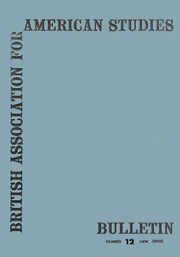No CrossRef data available.
Article contents
William Cobbett in North America
Published online by Cambridge University Press: 17 February 2011
Extract
Of his seventy-two years of life, William Cobbett spent approximately fifteen in North America, about one-third of his adulthood. This period is accounted for in three separate visits, each of which represents a distinct phase in Cobbett's life.
- Type
- Research Article
- Information
- Copyright
- Copyright © British Association for American Studies 1961




